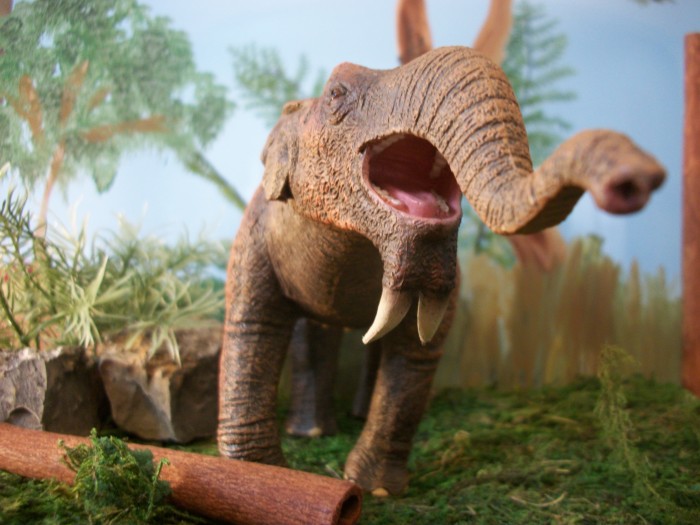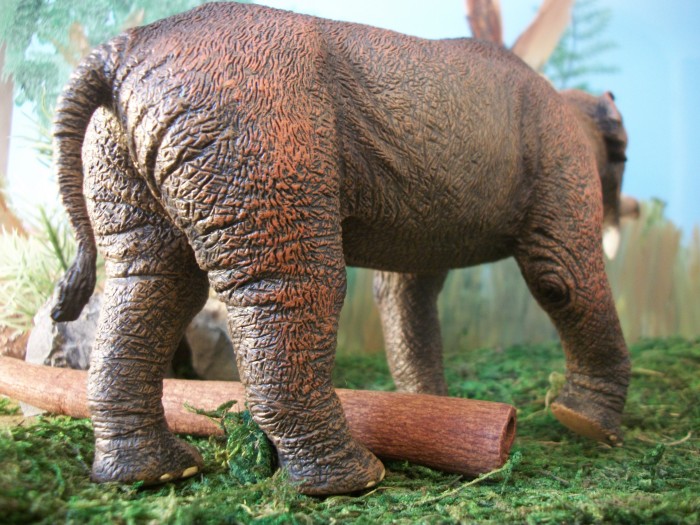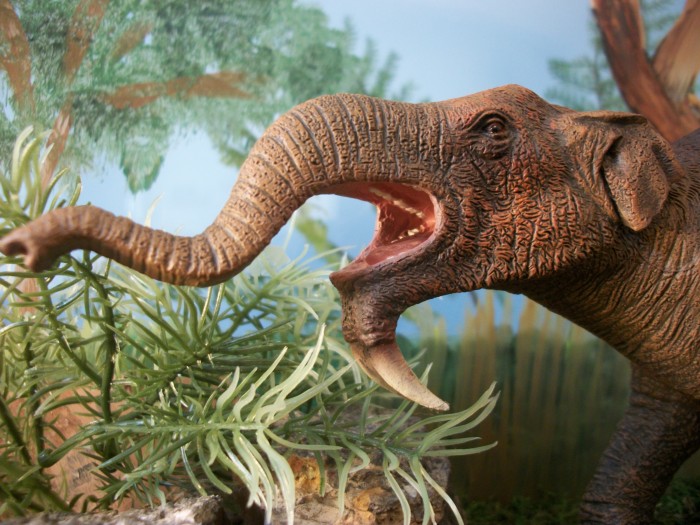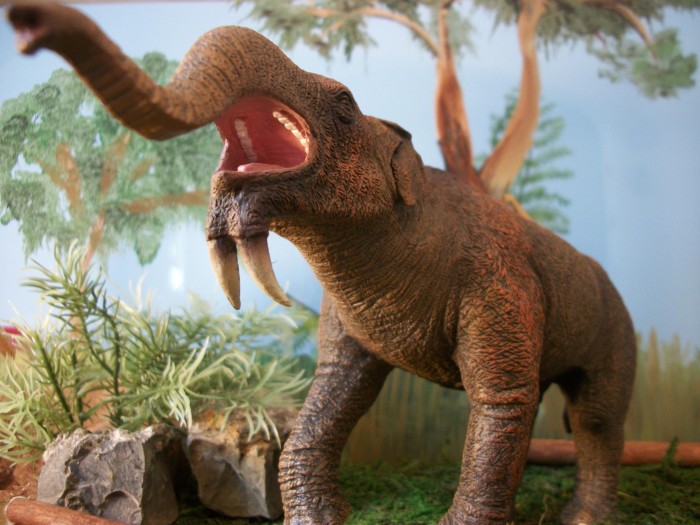History: One of the biggest Proboscideans of all time lived during the Early Miocene through to mid Pleistocene, yet it is largely forgotten by the general public. The Woolly Mammoth gets all the attention and love, with appearances in film, literature, and in toy form. The family of Deinotheriidae feels ancient as it branched away from the current extant species of Elephants earlier than most of the other families. Deinotherium “terrible beast “was successful during its day ranging from parts of Asia, Africa, and Europe. It had downward-curved lower tusks that are really fascinating and eye catching. In many ways it resembled today’s elephants with the major exception of the (incisors) short tusks on the lower jaw (modern elephants tusks stem from the upper jaw), a longer neck, and a skull that was short with a flattened top.
Imagine walking in a Miocene forest, on a warm comfortable day, the sun is shining; a slight breeze pleasantly touches your skin. You sit for a second enjoying the fine day, when suddenly you hear a crash that seemed to shake the ground behind you, as you turn, leaves and twigs are falling all around you. First you notice a long column of skin and muscle, as your head moves upward, you notice the beast belly is higher than you are tall. Higher still, you see a trunk reaching skyward grabbing a branch. Its head is way above you, as it grabs the twigs and brings down towards its mouth. The mouth on this beast looks strange and scary as two recurved tusks are pointing downward in your direction, sprouting from the lower jaw.
With that thought in mind let’s look at the 2013 CollectA Deluxe Deinotherium.
About the toy: The Deinotherium is in 1:20 scale and it is quite impressive. It is approx, 24 cent long and 12 cent high. The overall pose at first glance might not seem very dynamic. Once you look at the head positioning and its overall posture, you start seeing many possibilities. With the one foot raised, mouth agape, trunk straight ahead, it could pull off many different looks. It could be angry, or defending its territory from a rival or a predator. It could be thumping out its chest after achieving a victory over a predator or rival. Of course it could just be reaching for some tasty leaves.
As mentioned above, the head is raised and the mouth is agape showing off it molars and tongue. The trunk is short and waves straight out in front of the head. There is a small bump on the head behind the eyes. Smallish, Asian elephant like ears on the side of the head. The two recurved tusks are present at the bottom of the jaw, and curve nicely back toward the body. Moving on from the head there is a long, thick neck, which fits nicely into the shoulder girdle. There is small hump on the back, with a long body that ends at the long back legs and a tail that ends at the knee joint. The tail has a tuft of fur at the end.
The body is covered with detail. There are wrinkles aplenty and a light covering of fur, which covers most of the body, legs, and head. Present are skin folds between the legs, body, neck, and at the leg joints. The eyes are sculpted well and are painted glossy. The trunk is lined and has two holes at the end with a prehensile tip. The paint job is simple yet pleasing. It is painted brown with reddish brown highlights. The mouth and tongue are pink, with white upper and lower teeth. The tusks are ivory white and the toes are whitish as well.
Scientific accuracy: There is a lot to like about the sculpt and its accuracy. One interesting note is in most of the literature that I have read, it is considered naked, like today’s elephants, and not covered in fur like this model. I haven’t seen any evidence that states that it did not have some fur covering its body, so I am ok with the interpretation on the model. The only thing I feel that is truly inaccurate with this figure is the head. It should have a flatter skull; instead they put a round bump, where it should be flat. Other than that, I like the proportions, and think the rest of the anatomy looks spot on.
Playability: No problems here as it is quite a big and robust toy. The pose is exciting, lively, and quite useable for playtime. It looks like its bellowing to all comers saying “bring it”. It has an attitude and personality. The tusks are a little sharp, but are located in a way that it should never be an issue. The paint seems to be quite resilient and tough enough to stand up to hard playing.
Overall appraisal: One word, Awesome. From the moment I put my hands on it, this toy has simply captured my imagination. The size and pose are great, and the details are fantastic. Some scientific anatomy issues are present (skull), but nothing major in my opinion. There are some other Deinotherium toy versions out there from companies like Bullyland and Mojo so this isn’t the rarest of mammal toys though I wouldn’t say it is common either. I highly recommend this toy model for education, collectors, and for playing. If you are looking to purchase this amazing toy, it could cost you a little more than typical retail, due to many sellers placing a high price tag on it.
Available from Amazon.com here, and Ebay.com here.
Disclaimer: links to Ebay and Amazon on the DinoToyBlog are affiliate links, so we make a small commission if you use them. Thanks for supporting us!









Just received this model in the mail along with a few of the other CollectA cenozoic animals. Looks fantastic but is not really to scale with the other CollectA cenozoic animals (Kelenken and Daeodon) despite them all supposedly being 1:20. Somewhat disappointed but I would still buy it again.
A fantastic model one of the best out there, detailed, realistic, paint work superb, looks more like a pro made model rather than a toy. Collecta have really brought models to a new level
I believe recent literature (although I can’t find the exact source) has suggested that Deinotherium had a more tapir-like trunk–fatter and shorter than usually portrayed. I’ve been waiting for somebody to make a sculpt of that weird-looking head. 🙂
I think that the backdrop to this fine review certainly adds to its overall “curb appeal”. Looking over the collage of images for this genus on the internet, the great majority confirm your assessment that the skull should be flatter than this model’s. However, several did portray a somewhat more rounded top.Maybe this influenced CollectA’s sculpt.
I’ve obtained one of these and can confirm that it is another fine specimen by this rising company that seems to have surpassed some of the front runners of old .
Sweet! This magnificent titan is on my want list for this year!
And while it has been suggested that Deinotherium had a shorter trunk than those of modern elephants, it’s impossible to say for sure, not unless someone gets lucky enough to find a fossil with a soft tissue impression of the trunk. A longer trunk would certainly have made it easier for the big fellow to take a drink.
The commentary is great but there is a remark that would make deinotherium should not have such a fine trunk like this figure, nor modern elephants they do, even a prehistoric elephant as a much smaller tube, for me this is one of major figure flaws.
Otherwise I really convinces the prehistoric mammal.
I understand your concern about the trunk. When reviewing this toy, I did look into what the trunk, and what it could have looked like. It is suggested that it had a smaller, wider, trunk, but since I didn’t find any direct evidence of this, I decided to let the artist enjoy their interpetation, which in my opinon looks good on this model.
If Deinotherium really did have a tapir-like trunk, it must have been very annoying whenever it needed a drink. It would have had to wade right into a large body of water until it was deep enough for its mouth to reach the surface.